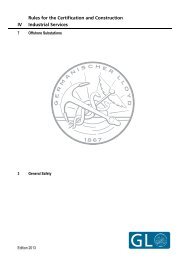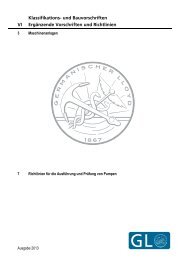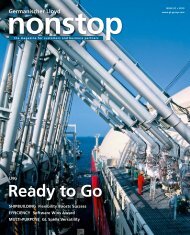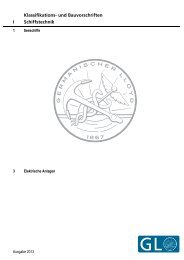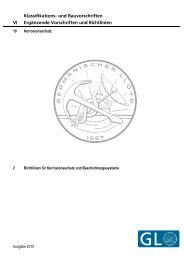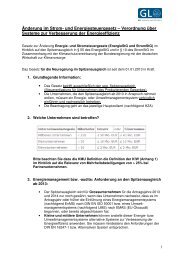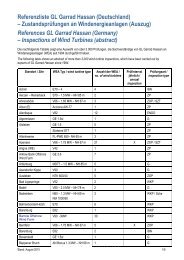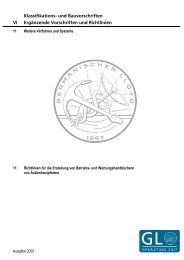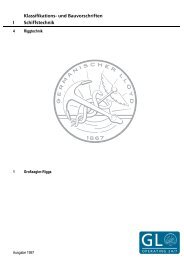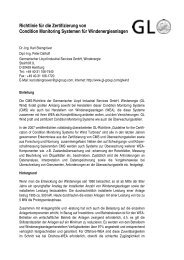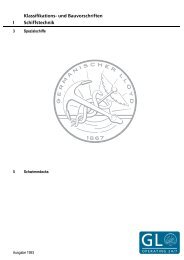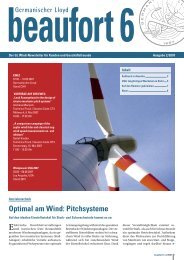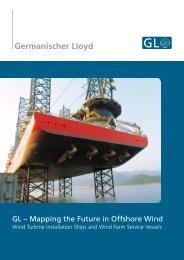Protection of Fuel Tanks Safety ahead! - GL Group
Protection of Fuel Tanks Safety ahead! - GL Group
Protection of Fuel Tanks Safety ahead! - GL Group
You also want an ePaper? Increase the reach of your titles
YUMPU automatically turns print PDFs into web optimized ePapers that Google loves.
Fluids in<br />
Motion<br />
What can earthquakes do to<br />
ship lift chambers?<br />
Germanischer Lloyd provides<br />
an answer<br />
Germanischer Lloyd investigated fluid motions<br />
caused by precalculated longitudinal (surge) and<br />
transverse (sway) motions <strong>of</strong> the lifting basin <strong>of</strong> the<br />
ship lift facility at China’s Three Georges Project. The investigation<br />
served to ensure the reliability and safety <strong>of</strong><br />
this facility when earthquakes occur. Both harmonic and<br />
inharmonic motions <strong>of</strong> the lifting basin as well as the corresponding<br />
accelerations, obtained from finite element<br />
structural computations carried out by Krebs und Kiefer<br />
International, represented earthquake events in China’s<br />
Three Georges area.<br />
The precalculated motions <strong>of</strong> the ship lift chamber may<br />
lead to water spilling over the chamber’s sides and cause<br />
high structural loads acting on the chamber’s walls and<br />
bottom, especially if the period <strong>of</strong> the water’s motion inside<br />
the partially filled chamber is close to the water’s natural<br />
period. Analytical methods are unsuitable to analyze<br />
this highly nonlinear phenomenon, called sloshing. Therefore,<br />
it was necessary to employ an advanced numerical<br />
technique to obtain accurate predictions <strong>of</strong> these sloshinginduced<br />
fluid motions and loads.<br />
Elaborate Analysis<br />
The technique employed is based on simulating the twophase<br />
flow by solving the Reynolds averaged Navier-Stokes<br />
equations (RANSE), using the finite-volume code Comet.<br />
This kind <strong>of</strong> code, implementing an interface-capturing<br />
technique <strong>of</strong> the volume-<strong>of</strong>-fluid type, is the obvious<br />
choice to compute complex free-surface shapes with<br />
breaking waves, sprays, and air trapping, phenomena that<br />
should be considered to predict hydrodynamic pressures.<br />
The conservation equations for mass and momentum in<br />
their integral form serve as the starting point. The solution<br />
domain is subdivided into a finite number <strong>of</strong> control volumes<br />
that may be <strong>of</strong> arbitrary shape. The integrals are numerically<br />
approximated using the midpoint rule. The mass<br />
flux through the cell face is taken from the previous iteration,<br />
following a simple Picard iteration approach.<br />
The flow field inside the ship lift chamber was computed<br />
as a transient process. The fluid domain was idealized<br />
by a volume grid comprising about forty thousands cells<br />
for the two-dimensional discretizations and about one million<br />
cells for three-dimensional dicretizations. On the wall<br />
surfaces a no-slip condition was enforced on fluid velocities<br />
and on the turbulent kinetic energy. The time step size<br />
was chosen such that the Courant number is unity on aver-<br />
Photo: Corbis<br />
Lock. A ship<br />
waiting to be<br />
hoisted.<br />
Simulation. The ship hoist at the<br />
dam.<br />
Time Series. Normalized water<br />
level in the caisson.<br />
SHIPLIFTING | MARITIME SERVICES<br />
age. The impulse equations<br />
were discretized<br />
using 90 percent central<br />
differences and 10<br />
percent upwind differences.<br />
The entire flow<br />
field was initialized by<br />
the hydrostatic pressure<br />
and zero velocity.<br />
At the ship lift chamber<br />
walls, no-slip conditions<br />
were enforced<br />
on fluid velocities<br />
and on the turbulent<br />
kinetic energy. Chamber<br />
motion was<br />
taken into account in<br />
two ways, namely, by<br />
moving the grid and by<br />
adding a variable body<br />
force due to chamber<br />
acceleration. Both<br />
methods gave nearly<br />
the same solution. For<br />
each time step up to ten<br />
outer iterations were needed.<br />
Various scenarios were investigated for different positions<br />
<strong>of</strong> the chamber in the lifting installation, whereby the<br />
chamber was subjected to harmonic as well as inharmonic<br />
motions. Results comprised time histories <strong>of</strong> water elevation<br />
inside the chamber, forces and moments acting on the<br />
chamber’s sides and bottom, and computer animations <strong>of</strong><br />
the water motion inside the chamber.<br />
In general, the chamber’s sway motions were found to<br />
be more critical than the surge motions, resulting in higher<br />
wave elevations in the chamber and larger loads on the<br />
cross walls and the bottom. Furthermore, harmonic motions<br />
caused higher wave elevations to occur than inharmonic<br />
motions. Consequently, harmonic motions tended<br />
to give rise to the largest wave-induced loads. The inharmonic<br />
sway motions did not cause the maximum water elevation<br />
to exceed the height <strong>of</strong> the chamber’s longitudinal<br />
and side walls. ■ OEM<br />
For further information: Dr Ould El Moctar, Head <strong>of</strong> Department, Fluid Dynamics,<br />
Phone: +49 40 36149-1552, E-Mail: ould.el-moctar@gl-group.com<br />
nonstop 04/2006<br />
23



